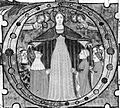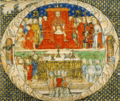Gian Galeazzo Visconti facts for kids
Quick facts for kids Gian Galeazzo Visconti |
|
|---|---|
 |
|
| Duke of Milan | |
| Reign | 5 September 1395 – 3 September 1402 |
| Coronation | 5 September 1395, Basilica of Sant'Ambrogio |
| Successor | Gian Maria Visconti |
| Lord of Milan | |
| Reign | 6 May 1385 – 5 September 1395 |
| Predecessor | Bernabò Visconti |
| Lord of Pavia | |
| Reign | 4 August 1378 – 5 September 1395 |
| Predecessor | Galeazzo II Visconti |
| Lord of Pisa | |
| Reign | 13 February 1399 – 3 September 1402 |
| Predecessor | Gherardo Appiani |
| Successor | Gabriele Maria Visconti |
| Born | 16 October 1351 Pavia, Italy |
| Died | 3 September 1402 (aged 50) Melegnano, Duchy of Milan, Italy |
| Burial | Certosa di Pavia |
| Spouse | |
| Issue |
|
| House | Visconti |
| Father | Galeazzo II Visconti |
| Mother | Bianca of Savoy |
Gian Galeazzo Visconti (born October 16, 1351 – died September 3, 1402) was a very important ruler in Italy. He became the first Duke of Milan in 1395. Milan was a powerful city in the late Middle Ages, just before the Renaissance began.
Gian Galeazzo also ruled the region of Lombardy with his uncle, Bernabò Visconti. He was known for building the Certosa di Pavia, a famous monastery. He also finished the Visconti Castle in Pavia, which his father started. He helped with the construction of the Duomo of Milan, a huge cathedral.
He took control of many areas in northern Italy and the Po valley. He even had disagreements with France over the control of Genoa and issues involving his daughter, Valentina. After he died from a fever, his children struggled to keep his lands together.
Contents
Gian Galeazzo's Life and Rule
Gian Galeazzo was the son of Galeazzo II Visconti and Bianca of Savoy. His father was the ruler of Pavia. Gian Galeazzo became known for his love of books and learning. He helped grow a large collection of scientific writings and beautiful manuscripts in the Visconti Library.
How Gian Galeazzo Took Power
In 1385, Gian Galeazzo took control of Milan from his uncle, Bernabò. He tricked his uncle by pretending to have a religious conversion. He then ambushed Bernabò during a religious parade in Milan. Bernabò was imprisoned and died soon after.
Expanding His Territory
After taking Milan, Gian Galeazzo quickly expanded his power. He took over cities like Verona, Vicenza, and Padua. He became the Signore (Lord) of these cities. Soon, he controlled almost the entire Po valley. This included Piacenza, where he gave land rights to the Confalonieri family in 1393.
He did lose Padua in 1390, but his power continued to grow. In 1395, he paid 100,000 florins (a type of gold coin) to Wenceslaus, King of the Romans. In return, he received the important title of Duke of Milan.
Big Building Projects
Gian Galeazzo spent a lot of money on grand projects. He spent 300,000 golden florins trying to change the paths of the Mincio and Brenta rivers. His goal was to weaken the cities of Mantua and Padua, making them easier to conquer.
He also had an amazing library in his castle in Pavia. It held many valuable manuscripts, some taken from lands he conquered. In 1400, he set up new departments to improve public health. He is often seen as creating the first modern system for government management and record-keeping. He did this with the help of his Chancellor, Francesco Barbavara.
Challenges with France
Gian Galeazzo was a very loving father to his daughter, Valentina. When he heard rumors about Valentina at the French Court, he threatened to declare war on France. The Queen of France, Isabeau of Bavaria, was the granddaughter of Bernabò Visconti. This made her a rival of Valentina and Gian Galeazzo.
Gian Galeazzo was also upset because France was gaining control over Genoa. He tried to stop this, but France warned him that further interference would be seen as an act of war. This disagreement was not just about politics. Valentina, who was married to the Duke of Orleans, had been forced to leave Paris. This was due to the actions of Queen Isabeau.
In 1396, after a big battle called the Battle of Nicopolis, there were rumors about Gian Galeazzo. Some thought he might have shared information with the Ottoman Empire about the Crusaders' plans. This was possibly due to his anger over his daughter being blamed for the illness of King Charles VI of France. It was also linked to France's growing control over Genoa.
Dreams of Uniting Italy
Gian Galeazzo dreamed of bringing all of northern Italy together into one large kingdom. He wanted to revive the old Lombard empire. But there were big challenges, especially from cities like Bologna and Florence.
In 1402, Gian Galeazzo attacked these cities. The fighting was very costly for everyone. Many believed that Milan would win. The leaders of Florence, like Chancellor Coluccio Salutati, worked hard to encourage their people. However, Florence was suffering from famine, disease, and poverty. Gian Galeazzo won another victory against Bologna at the Battle of Casalecchio in June 1402.
Gian Galeazzo's Death
Gian Galeazzo's dream of uniting Italy did not come true. He became sick with a fever at the Castello of Melegnano and died on September 3, 1402. After his death, his large empire broke apart. His children fought among themselves, and his lands were divided.
Family and Children
Gian Galeazzo was married twice and had several children.
First Marriage
His first marriage was to Isabelle of Valois. She brought him the title of Countess of Vertus in Champagne, France. This title was known in Italy as Conte di Virtù. They had four children:
- Gian Galeazzo (born 1366 – died before 1376)
- Azzone (born 1368 – died 1381)
- Valentina (born 1371 – died 1408). She married Louis I, Duke of Orléans in 1389.
- Carlo (born 1372 – died 1374)
Isabelle died in 1372 during childbirth.
Second Marriage
Gian Galeazzo then married his cousin, Caterina Visconti, in 1380. Caterina was the daughter of Bernabò Visconti. They had two sons:
- Gian Maria (born 1388 – died 1412)
- Filippo Maria (born 1392 – died 1447)
Gallery
See also
 In Spanish: Gian Galeazzo Visconti para niños
In Spanish: Gian Galeazzo Visconti para niños
- Montechino Italian Castle Piacenza






